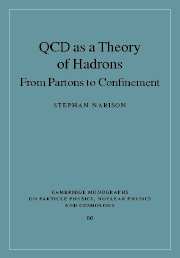Book contents
- Frontmatter
- Contents
- About Stephan Narison
- Outline of the book
- Preface
- Acknowledgements
- Part I General introduction
- 1 A short flash on particle physics
- 2 The pre-QCD era
- 3 The QCD story
- 4 Field theory ingredients
- Part II QCD gauge theory
- Part III MS-bar scheme for QCD and QED
- Part IV Deep inelastic scatterings at hadron colliders
- Part V Hard processes in e+e– collisions
- Part VI Summary of QCD tests and αs measurements
- Part VII Power corrections in QCD
- Part VIII QCD two-point functions
- Part IX QCD non-perturbative methods
- Part X QCD spectral sum rules
- Part XI Appendices
- Bibliography
- Index
1 - A short flash on particle physics
from Part I - General introduction
- Frontmatter
- Contents
- About Stephan Narison
- Outline of the book
- Preface
- Acknowledgements
- Part I General introduction
- 1 A short flash on particle physics
- 2 The pre-QCD era
- 3 The QCD story
- 4 Field theory ingredients
- Part II QCD gauge theory
- Part III MS-bar scheme for QCD and QED
- Part IV Deep inelastic scatterings at hadron colliders
- Part V Hard processes in e+e– collisions
- Part VI Summary of QCD tests and αs measurements
- Part VII Power corrections in QCD
- Part VIII QCD two-point functions
- Part IX QCD non-perturbative methods
- Part X QCD spectral sum rules
- Part XI Appendices
- Bibliography
- Index
Summary
Since ancient times, we have been curious to knowthe origin and the nature of the universe. Numerous ancient philosophers and scientists have tried to answer these fundamental questions. It is only at the present time of the twentieth millennium that we can provide a partial answer to these questions, as some significant progress has been accomplished in both particle physics and astrophysics, which are two areas of research in two apparently opposite scale directions (see Fig. 1.1).
On the one hand, this progress is due to our ability to explore the heart of matter, with powerful accelerators (where the accelerated particle has a velocity near to the velocity of light), which reveal their infinitely small, deepest structure (see Fig. 1.2).
As an example, we show in Figs. 1.3 and 1.4, the large electron-positron (LEP) accelerator and the reaction inside the detector after the collision of the electron and the anti-electron (positron). Notice that at LEP, the energy of the electron is in the range of 90-180 GeV which is about (5–10)×106 times the energy of our home TV screen. On the other hand, powerful telescopes (see Fig. 1.5) explore the enormous structure of the universe, and may reach the time of its origin.
- Type
- Chapter
- Information
- QCD as a Theory of HadronsFrom Partons to Confinement, pp. 3 - 9Publisher: Cambridge University PressPrint publication year: 2004



